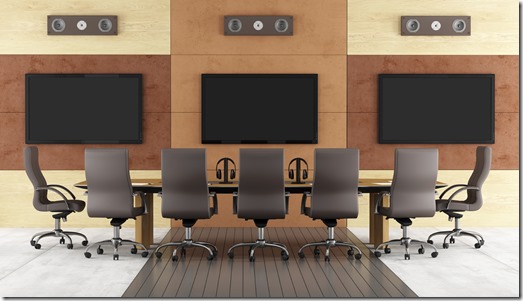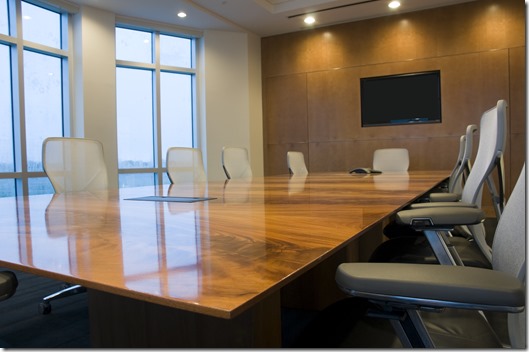When Public Speakers Should Be Stubborn And Fight
Hundreds of audio/visual technicians have helped me set up our media and presentation training sessions over the past decade. These professionals have bailed me out of more than a few jams, and I value their knowledge and expertise.
BUT…
I’ve consistently found that many A/V techs have a different view of what constitutes an “ideal” set up than I do. Oftentimes, they’ll set up the room in a manner that takes full advantage of the technology—but that isn’t conducive to student learning and public speaking.
As an example, a tech recently set up a room to look like the image below. But imagine one more empty table placed directly between the table with chairs and the screen, separating the speaker from the trainees by an extra few feet.
I was dismayed when I found that set up in the room (despite making a specific A/V request in advance), because I knew it wouldn’t work well for a full day of training.
Plus, I prefer speaking from the short end of the table, where I can take in the full room at a glance, instead of from the middle of the long side of the table, which forces me to constantly rotate back and forth.
I spoke to the tech and told him I’d like to try a different set up. He told me that his set up was the one most presenters used in that room. (I’ve heard that line many times—but given that many presenters aren’t all that great, that argument doesn’t warrant any merit.) He then tried to explain that the cords wouldn’t reach long enough with my preferred option. (Fortunately, I’ve learned just enough about technology to offer a solution he hadn’t considered.)
In the end, we made a few changes that made the room look more like the photo below.
As another example, I recently walked into a training room and saw the room set with chairs like this:
My trainees were adults, not seventh graders, and I didn’t want them to sit in grade school chairs for eight hours. We reconfigured the room with conference-style tables that fostered better collaboration and discussion.
As much as possible, it is your obligation as a speaker to create a speaking environment conducive to learning and participating.
To reduce the chances of something going wrong, you should speak to the A/V staff prior to the speaking day—but if you see something on the event day that you don’t like in the room, politely insist that the room be set the way you want it.
Good technicians are crucial allies—but their “best practices” and yours as a speaker may not align. You are the person in the front of the room, not them, so don’t simply defer to their expertise. Listen to their ideas and consider them—but don’t automatically yield to them.
Fight for what you want. Actually, that’s not exactly right. Fight not for what you want, but for what the audience needs to optimize learning.
Don’t miss a thing! Click here to instantly join our mailing list and receive the best of the blog twice each month.






I think many well-intentioned third parties try to tell their clients what they need, as opposed to listening to their clients. I’ve had IT staff tell me that I don’t need a particular piece of software when it’s actually something I use all the time and helps me get my job done. We’re dealing with issues with mobile app developers in which the developers put a “reader view” into the app that eliminates the ads from the app. They claim it’s a better user experience, but they fail to realize that the ads are what’s supporting the app as well as keeping the lights on in our offices. Everyone needs to do a better job of listening, instead of simply thinking of what they’re going to say next to defend their position. As George Bernard Shaw said, “The single biggest problem in communication is the illusion that it has taken place.”